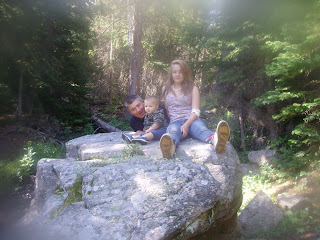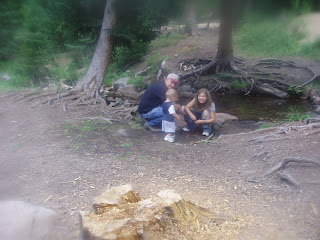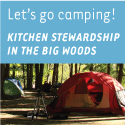
You are going to love this series! Millie (who blogs at Homespun Oasis) is a busy mom juggling alot. Yet, she pulled off a 10-day road trip eating pretty nearly 80% real food, and even more inspiring is that she wants to do it again next year! 🙂
This post is part 1 of what we’re calling her “Real Food On The Road” series. She shares how she planned and prepped for the road trip, including a very candid assessment of weak spots. Also check out Part 2 or the complete trip notes on her blog. Thanks, Millie! –Wardee
Recently, my family and I went on a 10 day camping/road trip. When we first began planning, one goal was to keep our traveling diet as real food friendly as possible. We know that our bodies do much better with whole foods prepared traditionally as opposed to standard processed food or dining out.
At home we are comfortable with buying and preparing ingredients that make this possible. We are fortunate not to have any serious food allergies and do have the ability to ‘stray’ a bit from our real food diet. I think we are about 80% real food and 20% not so real food (usually, through dining out or the occasional splurge of ice cream). Thinking about how to prepare the food we wanted in order to maintain our 80/20 goal while on the road and cooking of outdoors was a bit challenging for me.
The Planning
I was comfortable with planning out the first few days. By cooking ahead and stuffing a cooler (or two) we would be fine for two, three or maybe even four days. Planning for beyond those first days is what I wasn’t sure about. I knew I’d need to work off of a menu plan if I had any hope of meeting our goal of real food vs. not real. Because I know myself, without a plan in place the results could be dismal. We had a few months in which to plan for our trip so I used that time to put the menu together and even test new recipes. While putting menu ideas together I found many great ideas on the internet (of course).
Right here at GNOWFGLINS was a post from a couple of summers ago on eating real food while traveling. This post helped me think about how we wanted to eat and what might work. So the backbone of my plan was formulated from these two resources. But also, Katie Kimball’s Family Camping Handbook and the book Roughing it Easy by Dian Thomas gave me some great ideas and suggestions.
In order to really make a menu plan that worked I had to know our itinerary. We would not just be traveling to one spot, setting up a tent, and staying put for 10 days. We were first driving what we thought would be 18 hours straight through (turned out we were in the truck for about 25 hours instead), staying with family one night, going to my daughter’s college graduation (the reason for the trip), staying with different family the next night, camping (in a yurt) at the beach for three nights, driving a partial day and camping (yurt, again) one night, driving a full day and camping (teepee), then driving another day and camping (tent) before finishing with a final eight hour drive home.
With our travel plans in place it was somewhat easy to figure out what kinds of meals would work for each spot we were staying. We were even taking meals to share while we were with our families, since feeding an extra 5 mouths when used to feeding one or two can be a challenge. Plus I did have an ulterior motive of sharing how wonderful our real food items taste.
The Prep
Food prep began a few weeks before the trip by making a quart batch each of sauerkraut and cortido. I also made sure that I had my menu finalized and my to-do list written out. If it was going to work, I’d need to do a bit of advance cooking but also keep a list of what would need to be done each morning or evening for meals. Just like at home, things may need to be soaked or sprouted. I also planned on when/where I would restock for groceries and made grocery lists to go along with those stops. It sounds like a lot of work but it wasn’t very time consuming.

The week before we were to leave, I bought any non-perishables, and I also bought veggies that I planned on freezing for pizza toppings. I started putting together spice packets. By premixing taco seasoning and salad dressing seasonings for a few different types of salads I was able to leave my spice containers at home. I also premixed any dry ingredients for things that I could such as for Dutch Babies and Oatmeal pancakes.
I took advantage of pre-making things that would be okay if frozen. This would not only help with my meals but also act as the ice for the early part of the trip. I remembered reading a tip once from a full time RVing family that suggested to only buy frozen foods and never ice since the ice melts and makes a mess (boy, does it!) so thought I would utilize that tip with my made-at-home items.
The days before the trip were used to make up many foods like sourdough crackers, clabber cheese, kefir cheese, soft cheese, crispy almonds, sourdough tortillas, cooking 2 chickens in the crock pot (for sandwiches), baked oatmeal, Spice Cake, Impossible Brownies, and several other miscellaneous items. I figure I spent about six hours of hands-on time — and that gave us the bulk of our food for the first few days of our trip!
Campground Meals
Our meals at the campgrounds were somewhat ‘typical’ campground foods but with a bit of a twist. We did our best to still use quality ingredients and keep processed items down to a minimum. I will admit that we did eat more S’mores than we probably should have! But to counteract our splurges we tried to have something probiotic with our meals. Sauerkraut was a very welcome addition to our beef dogs and our campfire pizzas. Cortido was wonderful on tacos and eggs, as was kefir or soft cheese. A big jug of kombucha left home with us but was gone way too soon. Store-bought plain yogurt with fruit was also something we had several times and was quite tasty. I had considered taking my dairy kefir grains along but just couldn’t figure if I could make that work so we made do with taking along a quart to use in salad dressings. (Now I think I could have made it work.) We took 2-1/2 gallons of real (raw) milk which stayed good the entire trip by paying close attention to the temperature in our five day cooler.

Weak Spots
Our plan had a few weak spots. I packed up very well before we left, but each time we unpacked things seem to not fit nearly as well. And I took many things we ended up not really needing. We stopped once at an Oregon Trail marker that had reprinted letters from the travelers. One lady’s letter commented on how they had to set up camp each evening and break camp each morning. I guess that we had it easy in comparison!
Another weak area: I didn’t plan our breakfast times very well for the mornings that we were packing up to leave. Next time I’ll plan for an extra quick and easy breakfast that we can essentially eat on the road. We would be so excited to get going that sitting down to breakfast was a bit of a chore.
And I hate to admit that even with my plan in place, toward the end of the trip things became more challenging. We had planned on no more than three meals out (including our daughter’s graduation meal) but ended up with a fourth meal out. This occurred because we ran out of propane for the cook stove and I wasn’t able to precook our lunch for the next day. An hour away from the nearest store is not a good place to run out of propane! Next time I’ll remember to check the quantity of propane in the container.

All in all, we had a wonderful trip and are looking forward to a similar road/camping trip next summer that will be even a few days longer. While I think we did fall a bit short of our 80/20 goal we didn’t do too badly for the time we were on the road. I’m happy to say that cooking real food outdoors in a campground is really not much more difficult than cooking at home. I still think I’ll need a good plan in place and this time I have an entire year to work on it!
What real foods work for you while on a camping and/or road trip? Have you ever tried an extended trip lasting a week or more?
...without giving up the foods you love or spending all day in the kitchen!

2 free books:
Eat God's Way
Ditch the Standard American Diet, get healthier & happier, and save money on groceries...
We only recommend products and services we wholeheartedly endorse. This post may contain special links through which we earn a small commission if you make a purchase (though your price is the same).



This is the hardest part of traveling for me – making sure I get to eat what I know is healthy to eat. Kudos to you for making it work! 🙂
Hi Emily,
The slightly challenging part for me was figuring out what would work for the trip while the actual ‘doing’ was fairly easy. I was very surprised to find out a lot of real food items work quite well for camping style trips.
WooHoo going to check it out…we are leaving in 19 days for a trip and this will come in sooo handy!!!! THANK YOU!
Hi Alicia,
Hope there are some ideas you can use. Have a wonderful trip!
I can’t wait to hear more! Due to my husband’s job, fall is our travel time, and we already have at least one trip planned. I’m so inspired to try to feed my family healthy while we’re traveling!
Brittany,
I love off-season trips! You might wish to take a look at the link to my planning posts on my blog, I share our menu plans- some of which changed but still ideas for you.
Wow, great post!
I don’t have any camping experience as a real food eater 😉 But early this year we went on a backpacking trip from Quito (where I live in Ecuador) to Lima, Peru, for about 7weeks. We took a very small lugage for my 6yo son and I and stayed mostly in youth hostels.
We eat out quite a bit, but to be honest our food in Latin America is quite real even when you eat out 🙂
However, I made most of the breakfasts and dinners (lunch is our main meal here), and aoubt 50% of the time packed our lunch in our bento boxes to make a picnic.
I made yogurt in the hostels, bought organic food/eggs and visited traditional markets. I even made peruvian ceviche in the hostel, with the instructions I got from the fish vendor in the traditional market.
One thing that I didn’t do was sourdough bread, and I’m looking forward to find a way to take my starter in my backpack. Last trip I took a 3punds bread with me ;), but we had no more sourdough bread when we ate it up after a couple of weeks.
We’re planning a similar trip for next year, and I’m looking forward to improve our real/traditional and fermented food intake.
WOW Monica!
Your trip sounds wonderful. What kind of things did you put in the bento boxes? Your ideas for yogurt and ceviche sound great. I’m now wondering about doing counter top yogurt on our trip next year…
I will be sharing a post on what we did for bread so be sure to check back 🙂
It’s so interesting to read another real foodies perspective. Breakfast always takes #1 priority in my family, and we are first to eat and second to leave. Sometimes we leave later because of breakfast. You are the opposite. Again it’s refreshing to see other families perspectives 🙂
Meagan,
I was actually kind of surprised about our breakfasts. At home we do tend to have simple (rushed) breakfasts during the week but leisurely on the weekends. I thought our trip would be like weekend breakfasts but it didn’t turn out that way with all of the excitement of seeing new things. Surprisingly, our lunches were quite relaxed. Even when we would stop and picnic along the side of the road. I found it slightly amusing 🙂
When you say to put your lacto-fermented beets in cold storage does that mean they have to go in the refrigerator? I would like to put some up, but don’t really have room in my fridge and I don’t have a root cellar. I live in an apartment.
thanks
Candi
Candi — Storage for lacto-fermented foods is anywhere between 32 and 50 degrees Fahrenheit. So just out at room temperature doesn’t work. I am in the same boat, with little fridge space and no cellar. In fact, many people are. Modern homes are built differently and not often with traditional food preservation in mind. Another approach might be to ferment foods seasonally and enjoy them in season, not necessarily try to keep them for many months.
Millie,
Wonderful post and what great information for me to have, we leave on a 10 day trip come September. Eager to read the rest of your posts! Glad to have you back!
Hi Andi,
September will be a great time for a trip! Will you be camping or hotel staying? In this post, when I was asking for suggestions, the comments have some great ideas for both camping and hotel stays. http://realfoodforlessmoney.blogspot.com/2011/02/food-for-road-tripcamping-trip.html
Candi- I hear you! My family of six was in an apartment for a year and this was when I decided to truly take on real foods. lol What I found feasible was a complete overhaul of the upper shelf in my fridge for my jars of LF foods. I tried to stay organized and replace my store-bought items with homemade as I ran out. When the ketchup bottle was gone, I made a pint jar. When the mustard was gone, I made a 1/2 pint jar. Mayo, veggies and fruits were next and pretty soon, I actually had extra space on that top shelf! Somethng about making it all ourselves makes us better stewards of space AND money.
I was also buying 6 gallons of raw milk per week, so those went on the bottom. In the middle went meats and cheeses. Fruits and veggies in lower bins and that was it.
**************************************************************************************************************
These are great ideas! We have a roadtrip to CO planned for our family Christmas gift (instead of ‘zents) and will have to make notes! When we camp, I premake meals, seal in gallon zip locks, label them, and line up in the ice chest. Chili, Hungarian goulash, spaghetti, beans and rice, stir-fry, and chicken noodle soup all work well. If you freeze them, they keep very well. When we arrive and while my husband and kids are setting up, I dump it into the skillet and slowly heat. By the time we’re done, it’s hot and ready to go. Add a salad and a LF goodie, and we’re good.
I also like to use dry-ice. No soggy mess to deal with! Walmart often has this at the front of their stores. 😉
I have also plugged my crockpot into a power point in our Excursion. After an 8 hour drive, it’s nice to have two roasted chickens, potatoes, carrots and mushrooms waiting for us! Just make sure to have additional plastic bags for any leftovers. 🙂
Kristen,
Great idea to plug the crock pot into the car! And premaking and freezing is wonderful. I think I’ll try and do more of that for our next trip.